To learn more about what consumers think about their customer support experiences with businesses — especially in terms of how technology factors into their frustrations and happiness — Zoom commissioned a Morning Consult survey¹ in November 2022. The results indicate a gap between consumer expectations and what they actually experience.
Survey: High consumer expectations for customer support

- 01 Consumers have high expectations for customer support - Jumplink to Consumers have high expectations for customer support
- 02 Where businesses deliver and fail to meet expectations - Jumplink to Where businesses deliver and fail to meet expectations
- 03 Consumers will leave a brand after a bad support experience — and tell others - Jumplink to Consumers will leave a brand after a bad support experience — and tell others
- 04 The realities of phone and video support - Jumplink to The realities of phone and video support
- 05 Chatbots have entered the mainstream - Jumplink to Chatbots have entered the mainstream
- 06 The more people use chatbots, the more positively they view them - Jumplink to The more people use chatbots, the more positively they view them
- 07 Create a better customer support experience - Jumplink to Create a better customer support experience
- 08 Methodology - Jumplink to Methodology
In the past few years, consumers have doubled down on what they want from customer support. They expect faster, more accurate, and more efficient help on all channels. They want flexibility in the ways they get in touch; immediate answers, no matter where they live, or the time of day (or night). They want the right information, tailored to them, and they want professionalism and friendliness.
And they’re increasingly savvy. Consumers have now interacted with cutting-edge companies that have shown them technology does improve the support experience. Which ultimately makes them more frustrated when companies don’t deliver what they know is possible.
A great customer journey is table stakes for brands in today’s world. But to what degree? Just how quickly will customers not only leave a brand — but tell others to avoid them — after a bad support experience?
How much does technology help (or hinder) their experiences? What frustrates them about their support experiences? What are they hoping will change, both in terms of speed, accuracy, and even tone? How exactly do they want to receive support?
These are just a few of the questions Zoom wanted to explore in this survey. The results allowed us to determine the moments and situations that left customers feeling disappointed and frustrated, and conversely, the times when they felt the kind of satisfaction that builds trust and brand loyalty—factors that not only retain customers but drive long-term brand growth.
A few top findings emerged from this survey:
- If customers receive bad support, they’ll leave a brand. More than half (59%) would switch to a competitor after only one or two negative support experiences.
- They’re frustrated by getting bad information. When asked what contributes to a negative support experience, 54% said inaccurate resolutions.
- People hate waiting. 85% of consumers say short wait times should be provided as part of a support experience, but far fewer — only 51% — experience short wait times.
- Chatbots have entered the mainstream. 67% of consumers have used chatbots at least once in the past year. 81% of chatbot users said their most recent support experience was positive.
- Consumers want more video support. At least half of them would consider using live video to get help, but only 24% have actually used live video support.
Here’s a more in-depth look at our findings:
As the pace of global commerce and technology evolves, consumers have a different set of expectations from customer support. According to our survey, some of the top things they expect are:
- Knowledgeable representatives
- Accurate resolutions
- Fast resolution
- Friendliness
Nearly all of consumers (90%) agreed that accurate resolution and knowledgeable representatives should be provided by customer support. Eighty-nine percent of respondents say support should be friendly and the same amount said they expected support to be easy to contact.

Businesses fail to meet consumer expectations for short wait times, with a 34 percentage-point difference between the expectation for short wait times (85%) and actually experiencing short wait times (51%).
Inaccurate information frustrates customers. When asked what factor contributes to a negative support experience, 54% said inaccurate resolutions, and 52% said long wait times.
At the same time, some companies are meeting consumer expectations. A majority of consumers (78%) say that their experiences with customer support are friendly. Seventy-two percent say they’ve been helped by knowledgeable representatives, and 74% have received accurate resolutions to their issues.
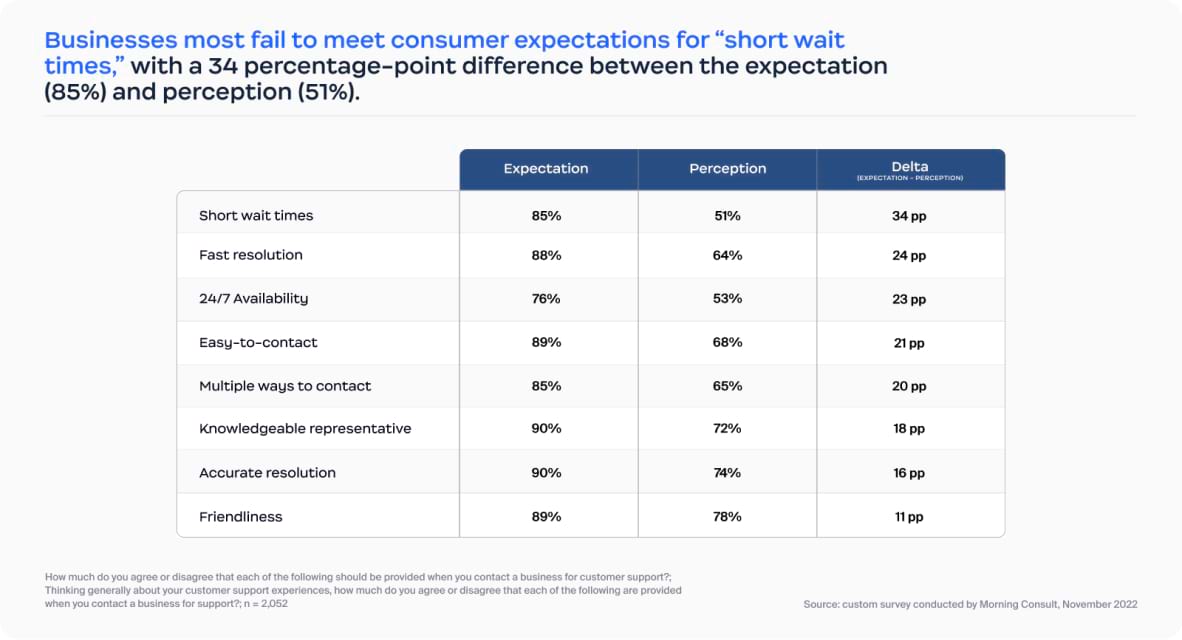
Not only do customers expect immediate and efficient customer support, but they’ll also abandon a brand when they don’t get just that. More than half of people (59%) would switch to a competitor after just two negative support experiences. And nearly 2 out of 10 people would switch after just one negative experience.
The effects of a negative support experience ripple outward — it goes beyond losing just one customer. Negative support experiences inspire consumers to tell everyone from friends and family to anyone who reads their social media posts and negatively affect your Net Promoter Score (NPS).
- 57% percent say they’d tell a friend or family member to avoid the company
- More than a third would write a negative online review, and 31% would mention the company on social media
Those with higher incomes are even more impatient. Sixty-eight percent of people who make more than $100,000 annually were likely to switch to a competitor after one or two negative support experiences.
Conversely, do consumers reward a brand for a positive support experience? Absolutely. Consumers are more than twice as likely to buy from a company after a positive support experience than after a negative one.
- 79% of consumers who had a positive support experience would recommend the company
- 60% would write a positive online review
- 46% said they’d mention the company on social media
Customers are more than twice as likely to buy from a company after a positive support experience (87%) than after a negative one (35%).
Even as so many consumers adopted new technologies during the past few years, phone support reigns as the most commonly used form of support. But the data shows a shift in perceptions — consumers are using, and want to be using, emerging methods of support, especially video.
Ninety-four percent of people surveyed used live phone support at least once in the past year. A majority of consumers consider live phone support the best for professionalism (88%) and knowledgeable help (86%).
The rise of emerging methods is particularly evident with video support. Nearly a quarter of people have used live video support, and one in three would consider using video (31%) in the future. At least half of consumers would consider using live video for help with an issue or problem (54%), or requesting a refund (50%).
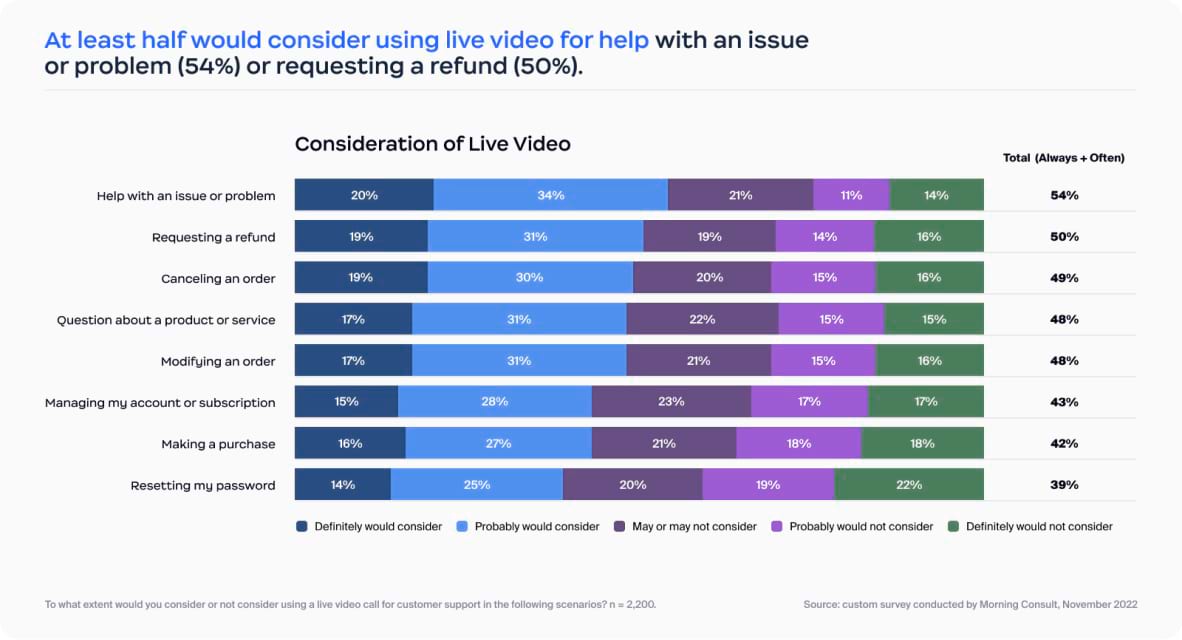
Younger audiences, ages 18-29, are more interested in using video for support than other age groups.
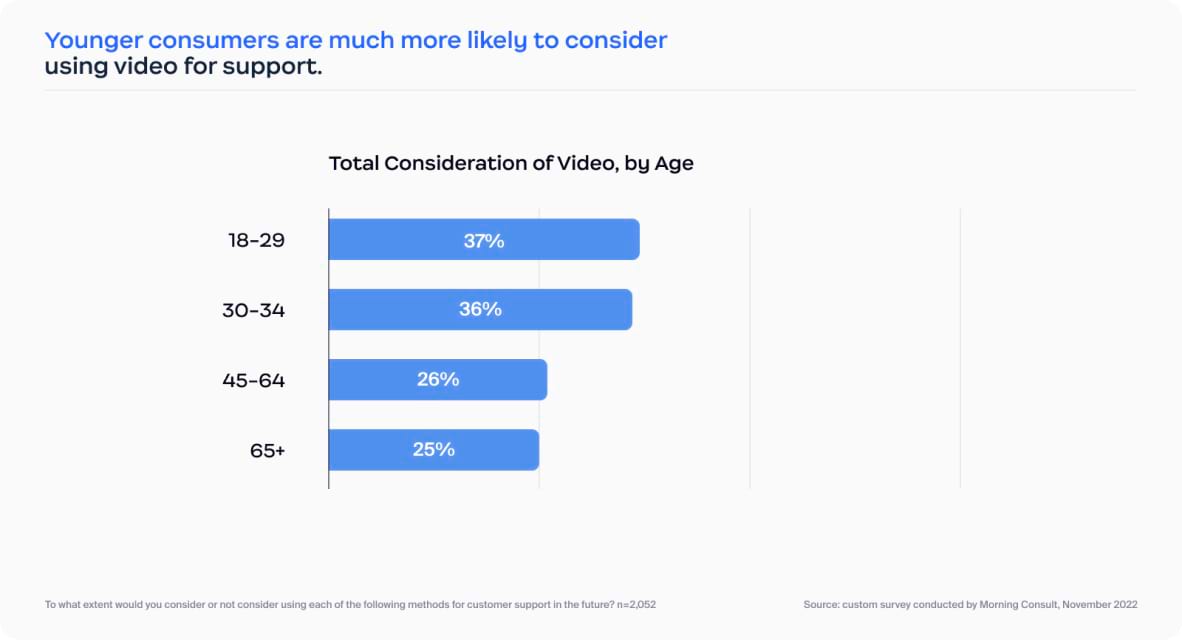
As chatbot technology continues to evolve, there’s no question that the availability and quality of chatbots have reshaped consumer attitudes.
Sixty-seven percent of consumers have used chatbots at least once in the past year and 42% are comfortable using them.
Consumers who’ve used chatbots have a vastly more positive experience than a negative one. Eighty-one percent of chatbot users say their most recent support experience was positive.
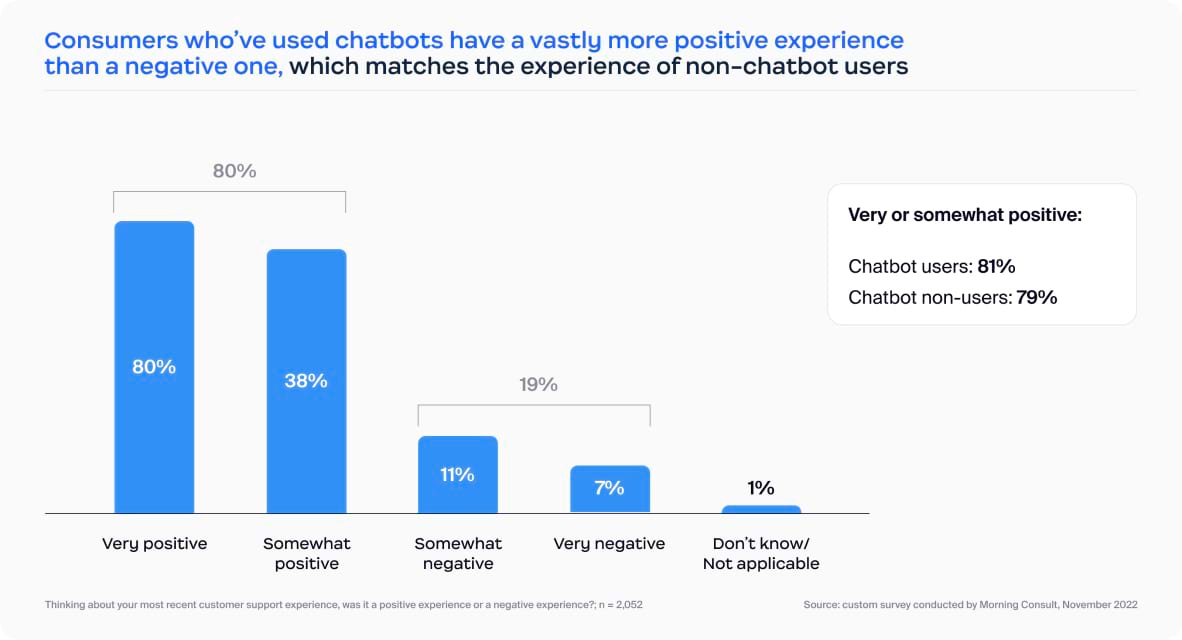
Yet among those who use them, just 29% say chatbots successfully resolve their issues “often” or “always,” showing that there’s still room for improvement in the quality of chatbots.
Although a majority of chatbot users (60%) say they often or always need a handoff to an agent, fewer (43%) are often or always able to reach one — a confirmation of the widely held belief that companies and agents are “hiding behind” chatbots.
Chatbots are viewed as the best choice for short wait times and 24/7 availability, areas in which support is currently failing to meet overall consumer expectations. In fact, 67% of chatbot users said 24/7 availability was one of the top three advantages of a chatbot, and 34% ranked it as the number one advantage, followed by short wait times and convenience.
At the same time, more than two-thirds of chatbot users (68%) said one of the top three disadvantages of a chatbot was its inability to understand them and 27% ranked it as the top disadvantage — another signal chatbot technology isn’t yet matching consumer expectations.
Chatbot inability to understand requests may explain why consumers may still view chatbots as reliable only for the basics. The most preferred scenario for using a chatbot is resetting a password, while email support was preferred for the reset by more than 1 in 3 consumers (34%).
Younger audiences have a higher interest in using chatbots. More than half of consumers aged 18-29 said they’d consider using chatbots for customer support.
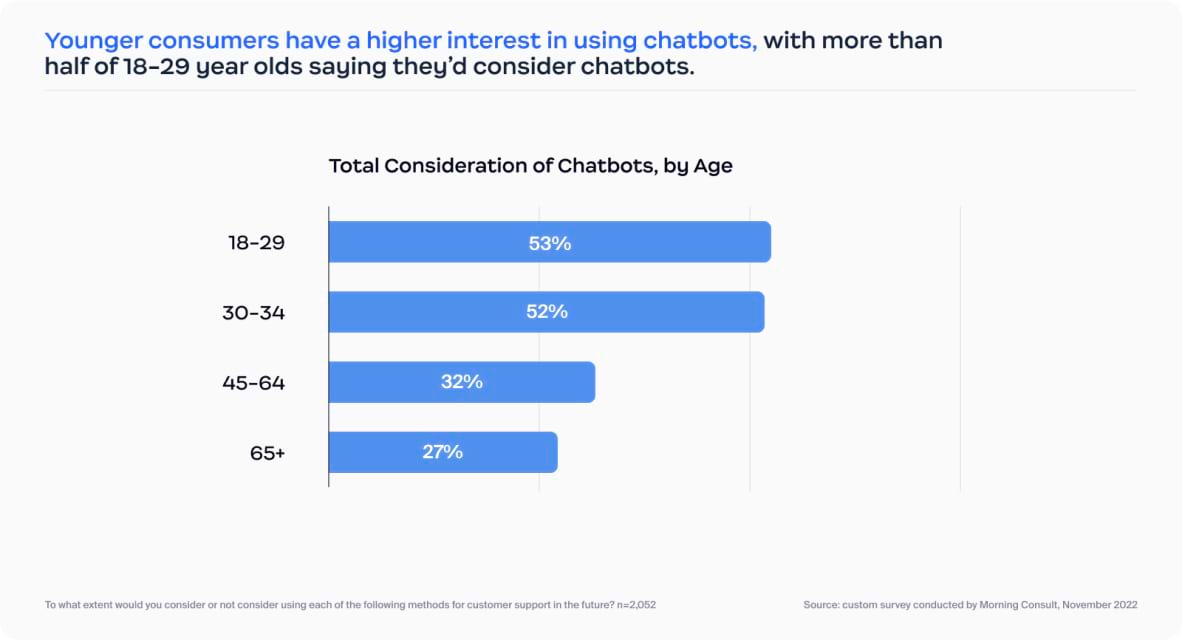
A growing segment of people use chatbots more than once a month (23%). These “power users” have a more positive view of chatbots than other consumers. As chatbot technology continues to advance, more consumers will join this growing segment.
Power users have a significantly better perception of what chatbots can do, and they’ve experienced personalized and advanced chatbot journeys, which other groups may have not yet experienced. When compared to infrequent chatbot users:
- 22% more of power users say chatbots are knowledgeable
- 24% more of power users say chatbots provide accurate resolutions
- 26% more say chatbots are fast
- 29% more say chatbots are friendly
- 49% more say chatbots are personal
Power users see the value in chatbots being “always on.” Sixty-four percent of power users say 24/7 availability is provided when they contact a business for support.
Chatbot power users are more likely to take action after a positive experience with a company’s customer support.
- 72% are likely to write a positive review
- 60% are likely to mention the company on social media
How can you meet your customers’ expectations for fast, accurate support? The omnichannel Zoom Contact Center makes it easy to deliver prompt, accurate, and highly personalized customer experiences that drive loyalty. With Zoom Contact Center you can:
- Provide instant, accurate resolution 24/7 and reduce call volume with Zoom Virtual Agent, an intelligent conversational AI chatbot. Brands using conversational AI technology see an average 61% self-service rate.*
- Provide intelligent hand-offs, so customers can easily reach agents when needed.
- Enable your contact center agents to use the same app to connect with back-office experts while engaging with customers.
- Solve issues faster and more efficiently with built-in video, which lets agents and customers screen and file share, and chat.
- Optimize your contact center performance with real-time KPI alerts, customer satisfaction insights, and agent productivity metrics.
Top companies like Chime Solutions, Optiv, First Federal Credit Union, and FranklinCovey choose Zoom Contact Center to deliver exceptional experiences to their customers.
“With Zoom Contact Center, our supervisors have the ability to organize service representatives based on skills,” says Chris Neal, Senior Vice President of Operations at First Federal Credit Union. “Now we can route their inquiries directly to experts that are equipped to handle their unique needs.”
Learn more about Zoom Contact Center and Zoom Virtual Agent.
*Historical data from Solvvy, now known as Zoom Virtual Agent.
This survey was commissioned by Zoom and conducted by Morning Consult among 2,200 general population adults in the United States from November 1 to November 2, 2022. The data were weighted to demographically reflect the makeup of the U.S. adult population. The margin of error for this study is +/- 2 percentage points.
Deliver exceptional customer service at scale
Zoom Contact Center helps businesses deliver prompt, accurate, and highly personalized customer experiences that drive loyalty. Find out how you can deliver a better customer experience with intelligent self-service and video for high-touch engagements.